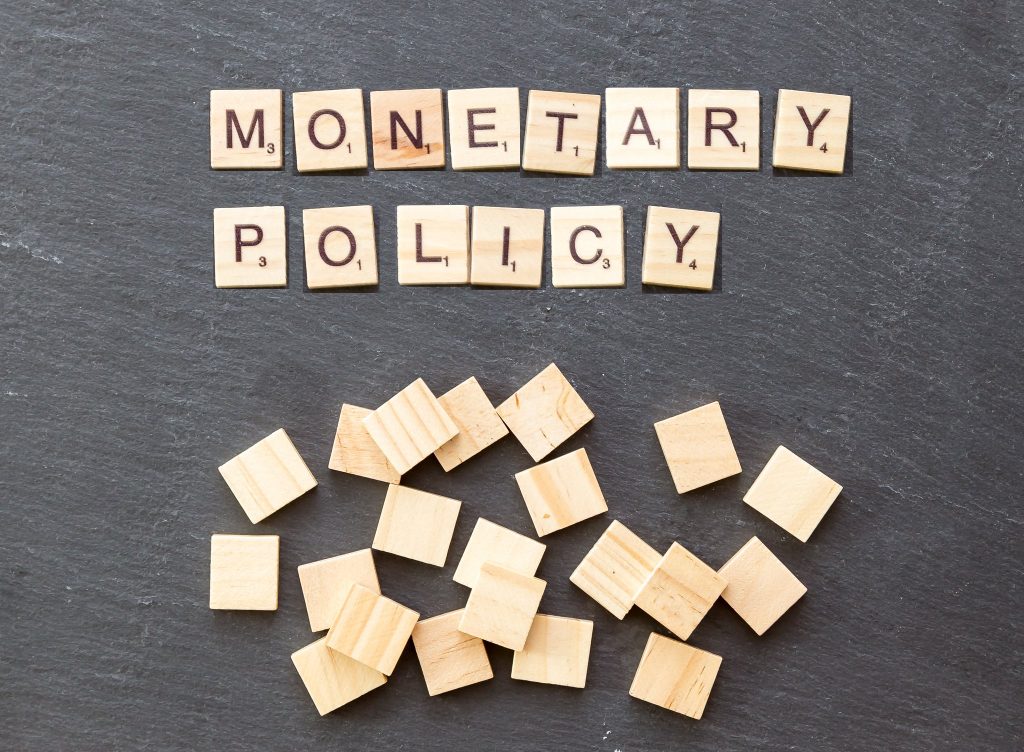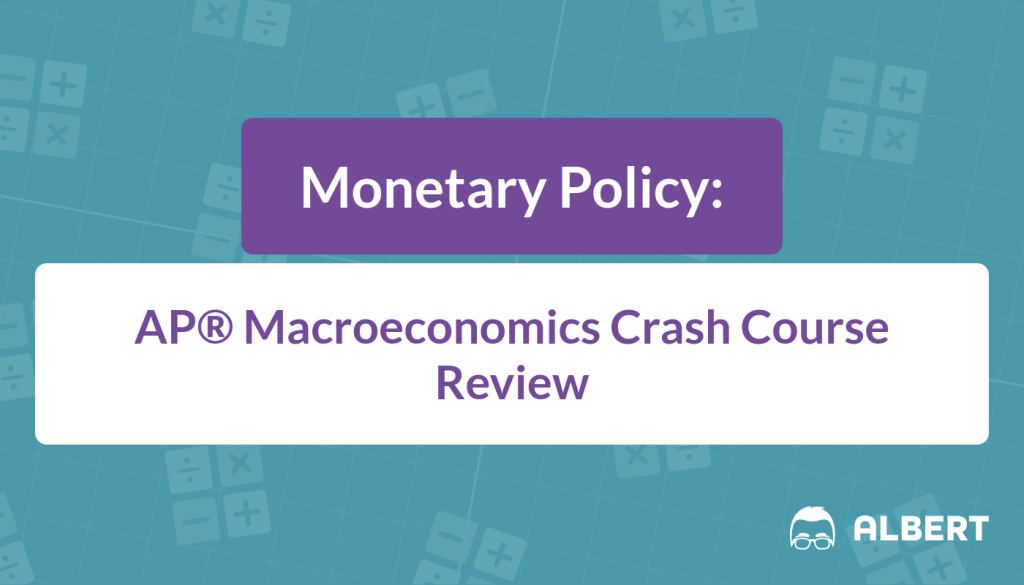You may have heard about the Federal Reserve from the news, such as when it adjusts interest rates or starts to buy bonds to increase the money supply. Federal Reserve’s monetary policy works in conjunction with the government’s fiscal policy to control the economy’s stability.
It should be noted that the Federal Reserve is an independent entity from the national government. While it was created by an act of Congress, the only governmental intervention into the Federal Reserve’s actions comes from presidential appointments to the leadership positions in the bank. It otherwise runs independently based on its own policy goals and the opinions of private bankers.
An additional note should be made that the Federal Reserve is just one example of monetary policy in the world. The system of Federal Reserve banks acts as a central bank that is equal to the Bank of England for the United Kingdom or the Bank of Japan. The AP® Macro exam almost exclusively concentrates on the actions of the Federal Reserve.
What is Monetary Policy?

Monetary policy is created through the actions of the central bank on the money supply and interest rates. It works to either create a business friendly economy to spur employment and growth, or a policy to reduce national spending to try to lower the inflation rate.
It has three ways of controlling the economy:
| Options | Actions |
| Open Market Operations – Buying or selling bonds on the open market | Buying and selling bonds to increase money supply |
| Reserve Ratio – The amount of money banks are required to keep in reserve before lending. | Raise or lower the ratio to affect how much a bank needs to save |
| Discount Rate – The rate the government charges banks for borrowing money. | Raise or lower the interest rate |
Much like the federal government’s fiscal policy, the Federal Reserve’s monetary policy has two types of policies to control the economy. The policy it chooses to use depends on the economic outlook in both the long run and short run. The two types of policy are:
I. Contractionary Policy
During inflationary periods the Federal Reserve will attempt to reduce inflation by taking actions that increase savings and reduces spending. These two effects will eventually lower the price level in the overall economy. This is done through one of the three actions.
- The Fed may participate in the money market by selling government bonds, which reduces the money supply and therefore the price levels.
- The Fed can raise the reserve ratio, which increases the amount banks have to save. They therefore cannot lend as much as before and this reduces the amount of money in the economy.
- The Fed can raise the discount rate, which means that banks are charged more for borrowing from the Fed. This will lower demand for borrowing and therefore lower the money supply.
II. Expansionary Policy
During recessionary periods the Federal Reserve wants to increase inflation and employment in order to spur the economy. The Fed gives incentives to banks and businesses by increasing the money supply which therefore increases spending.
- The Fed buys government bonds, which is a sort of loan the bank or private entity makes to the Fed with a low interest rate. Buying bonds increases the money supply by giving lenders back their money, plus interest.
- The Fed lowers the reserve ratio, which therefore allows banks to lend more money to borrowers. This increases investment and spending.
- The Fed can lower the discount rate, which makes borrowing from the Federal Reserve more desirable. Banks will ask for more money and the money supply will increase.
To sum up the two policies, you have to understand that the Federal Reserve has two options depending on the state of the economy. It can increase the money supply and therefore increase investment and spending, or decrease the money supply to the opposite effect. In addition, it can control interest rates of government loans that regulate how much a bank will borrow.
The Effects of Monetary Policy on Banks
Most questions involving AP® econ monetary policy will involve figuring out how profitable a bank is and how the reserve requirement ratio affects the bank’s balance sheet. The balance sheet is an overall review of all of the bank’s money. It is calculated as the bank’s assets, or the money it owns, versus its liabilities, or money that has been borrowed and it owes.
The bank’s balance sheet should be balanced; meaning the amount of liabilities has to equal the amount of assets. Let’s say you own a bank, here is what your balance sheet might look like:
Situation 1:
| Assets | Liabilities |
| $50 Reserves
$40 Excess Reserves $5 loans $5 bonds |
$100 Demand Deposit |
Looking at the balance sheet, you can see that there is a value of $100 on each side, showing that your bank is balanced between its assets and liabilities. The only liabilities you have for now are known as “Demand Deposits.” These are the deposits made by your clients and you have to be able to pay out that money if the clients demand it.
The reserve is the amount the Federal Reserve requires that you keep on hand in case there is a run on your bank. In your AP® Macroeconomics review, you will have to figure out how much this reserve percentage is based on a balance sheet. According to the above balance sheet, your bank currently has to reserve 50% of its deposits, or $50 for every $100 in Demand Deposits.
Situation 2:
| Assets | Liabilities |
| $50 Reserves
$40 Excess Reserves $5 loans $5 bonds |
$150 Demand Deposit |
Now we change it where your bank has received a deposit of $150. According to the reserve ratio of 50%, you have to reserve 50% of your client’s deposits and then you can use the rest of the deposit however you please by either loaning the money out or keeping it as excess reserves. This situation might result as follows:
Situation 3:
| Assets | Liabilities |
| $75 Reserves
$50 Excess Reserves $10 loans $15 bonds |
$150 Demand Deposit |
As a result of the reserve requirement, your bank has added $25 of the $50 deposit to your reserves. You then went on to add $10 to your excess reserves. The other $15 is lent out as loans or used to buy government bonds ($5 and $10, respectively).
On the AP® Macro test, you will have to figure out the reserve ratio and then how this ratio affects how the bank will use its money afterwards, as shown in the above example. Conversely, you will have to make the appropriate changes in the case of a withdrawal from the bank (say, a customer takes out $50).
The Effects of Monetary Policy on International Exchange
Specific monetary policies also affect the way consumers buy and sell a currency on the international exchange market. Additionally, it affects the imports and exports of a country. Because the dollar is as influential as a medium of exchange throughout the world, the Federal Reserve’s policies are closely watched by economists.
In the event of contractionary policy, the Fed will begin reducing the money supply. As stated previously, this causes people to save more and buy less. Because this lowers prices throughout the country, the value of the dollar goes up. This negatively affects exports, as other countries will be less likely to buy more expensive products from the United States.
In contrast, during expansionary policy the Fed increases the money supply. As a result, people spend more and inflation rises, lowering the value of the dollar. On an international scale, the market will begin buying more dollars and products that are priced in dollars as they take advantage of lower costs and exchange rates.
Many people try to make money from these fluctuations by buying a currency when it is worth less and then selling it when it is in higher demand. This is a very risky practice because it is hard to tell when the central bank will increase or decrease the money supply. It also requires paying attention to two economies at once, as it implies saving in one currency while waiting for the other to depreciate.
Conclusion
Monetary policy is the way that a country’s central bank attempts to control the economy. It does so by using various methods to increase or decrease the money supply. Increasing or decreasing the money supply is seen as either expansionary or contractionary policy.
The way the Federal Reserve controls the United States’ economy also has an effect on the international economy. Today, the Federal Reserve has been keeping interest rates close to 0% in an effort to spur more investment and continue recovery from the 2008 Financial Crisis. This is an example of how the Federal Reserve is using expansionary policy to help the economy.
However, this policy is not sustainable forever and eventually you might notice the signs of a contractionary monetary policy. In current headlines, many business savvy people are speculating that the Federal Reserve Board’s current chair is planning on raising interest rates for the first time since 2008. It will be interesting to see how this policy will affect the economy at large.
Looking for AP® Macroeconomics practice?
Check out our other articles on AP® Macroeconomics.
You can also find thousands of practice questions on Albert.io. Albert.io lets you customize your learning experience to target practice where you need the most help. We’ll give you challenging practice questions to help you achieve mastery of AP Macroeconomics.
Start practicing here.
Are you a teacher or administrator interested in boosting AP Macroeconomics student outcomes?
Learn more about our school licenses here.








